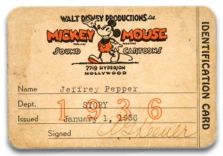 It is well near impossible to underestimate the importance and impact of The Old Mill, Disney's classic Silly Symphony that was released seventy years ago on this date. Cited most often as the first film to employ the multiplane camera, its merits extend well beyond that particular technical innovation. In their now classic book Disney Animation: The Illusion of Life, Frank Thomas and Ollie Johnston succinctly describe why The Old Mill is so notable and important, even beyond the achievement of the camera itself:
It is well near impossible to underestimate the importance and impact of The Old Mill, Disney's classic Silly Symphony that was released seventy years ago on this date. Cited most often as the first film to employ the multiplane camera, its merits extend well beyond that particular technical innovation. In their now classic book Disney Animation: The Illusion of Life, Frank Thomas and Ollie Johnston succinctly describe why The Old Mill is so notable and important, even beyond the achievement of the camera itself:By 1936, a new type of picture was becoming possible. Technical skills were advancing and a new camera was being built that promised wonderful illusions; animation of rain and clouds and lightning had improved to the point where they were quite convincing; cartoon colors were beginning to glow; and new styling coordinated all of a film's parts into one unified concept. When these achievements were combined with the ability to portray mood on the screen, a true milestone in the development of the animated cartoon resulted: The Old Mill, Academy Award winner for 1937. With no story other than the reaction of various animals to one stormy night in a broken down mill, the film showed that an audience could be swept up by sheer artistry and become deeply involved in an animated film.
Echoing similar themes, authors Russell Merritt and J.B. Kaufman remarked in their recent excellent and extensive tome Walt Disney's Silly Symphonies:
This is the first Disney film meant to be taken seriously, the first with quasi-religious overtones in which art, nature, and machinery are given a sacred aura.
Much could certainly be written about The Old Mill, from the specific technical intricacies of the multiplane camera to the film's numerous awards and accolades. But its very simple, yet stunning interpretation of life, death and renewal is what truly resonates and continues to distinguish the film some seven decades later.
 The Old Mill, under the inspired direction of Wilfred Jackson and Graham Heid, is brilliant in both composition and visual direction. The viewer is literally drawn into this microcosm of nature, almost as if taking the form of an incorporeal spirit and witnessing the events that subsequently transpire. This is in fact a deliberate dynamic created by the film's makers, in that frequently, the various creatures seem to acknowledge the viewer, most notably an especially observant owl.
The Old Mill, under the inspired direction of Wilfred Jackson and Graham Heid, is brilliant in both composition and visual direction. The viewer is literally drawn into this microcosm of nature, almost as if taking the form of an incorporeal spirit and witnessing the events that subsequently transpire. This is in fact a deliberate dynamic created by the film's makers, in that frequently, the various creatures seem to acknowledge the viewer, most notably an especially observant owl.The film opens some distance from the mill, as seen from the perspective of an orb weaver spider meticulously crafting its web. A slow and methodical zoom brings us in closer to the mill as we witness ducks and cows in their deliberate motions and travails. The focus settles on a small songbird whom we follow into the mill's interior to its mate and a nest of eggs. In a truly amazing vertical tracking shot attributed to animators Bob Wickersham and Stan Quackenbush, we travel from the building base to its peak, along the way encountering mice, doves, the aforementioned owl and finally a colony of bats who, with the approaching dusk, take leave and return us to mill's surrounding community of residents.
 A cacophony of frog croaks and cricket sounds becomes an entertaining musical interlude. In perhaps one of the film's most stunning scenes, fireflies dance before the backdrop of the mill. This all leads to the climatic and visually mesmerizing thunderstorm. Drama unfolds as the mill residents attempt to survive an assault that culminates in a dramatic lightning strike.
A cacophony of frog croaks and cricket sounds becomes an entertaining musical interlude. In perhaps one of the film's most stunning scenes, fireflies dance before the backdrop of the mill. This all leads to the climatic and visually mesmerizing thunderstorm. Drama unfolds as the mill residents attempt to survive an assault that culminates in a dramatic lightning strike.
 Dawn arrives, peaceful and serene. The bats return from their nightly sojourn and we journey through and away from the mill much in the reverse manner of how we initially approached it. Starting at peak, we descend through the mill's now slightly more disheveled interior and revisit again the owl, doves, mice and a nest of newly hatched songbird young along with their attentive and proud parents. Retreating back from the mill, we see ducks and cows reversing their prior travels and we ultimately return to the spiderweb of the film's beginning, destroyed, yet still beautiful in its rain soaked glistening. While the mill's residents have ultimately weathered the storm, in a subtle testament to the nature of life and death, it is the fate of the distant spider that is questionable.
Dawn arrives, peaceful and serene. The bats return from their nightly sojourn and we journey through and away from the mill much in the reverse manner of how we initially approached it. Starting at peak, we descend through the mill's now slightly more disheveled interior and revisit again the owl, doves, mice and a nest of newly hatched songbird young along with their attentive and proud parents. Retreating back from the mill, we see ducks and cows reversing their prior travels and we ultimately return to the spiderweb of the film's beginning, destroyed, yet still beautiful in its rain soaked glistening. While the mill's residents have ultimately weathered the storm, in a subtle testament to the nature of life and death, it is the fate of the distant spider that is questionable. As noted, The Old Mill was a dramatic departure for Walt Disney, and especially remarkable in that it was less than a decade removed from the more primitive presentations of Steamboat Willie and The Skeleton Dance. In theme and execution, it paved the way for much of what would emerge a few years later in Fantasia. It's opening scene would be reinterpreted close to fifty years later for the equally stunning opening sequence of The Rescuers Down Under.
As noted, The Old Mill was a dramatic departure for Walt Disney, and especially remarkable in that it was less than a decade removed from the more primitive presentations of Steamboat Willie and The Skeleton Dance. In theme and execution, it paved the way for much of what would emerge a few years later in Fantasia. It's opening scene would be reinterpreted close to fifty years later for the equally stunning opening sequence of The Rescuers Down Under.The Old Mill is an amazing and notable achievement, a film whose depth extends well beyond the visual dynamic afforded to it by one of the Disney Studio's most famous innovations.



















5 comments:
Excellent review! The Old Mill is easily one of my favorite Disney films... Perhaps even my favorite short subject, just as Fantasia is my favorite Disney film. And this is probably for the same reason: the pure craft of animation as art in its real peak, classic era.
There is a plot, as you outline, but it's mostly a fig-leaf. It's as deep a plot as "dinosaurs fight", "demons celebrate a bacchanal" or "fairies bring the seasons". It's just the art up there... the few minutes of full, intricate, sublime, beautiful, watercolored, incredible moving art.
Somehow or other, my Halloween Disney viewing ritual works itself into a kind of order of increasing artistic significance. I'll start off with The Skeleton Dance and The Haunted House, go on to Lonesome Ghosts and Legend of Sleepy Hollow, and then top it off with The Old Mill and Night on Bald Mountain/Ave Maria... Perhaps the three (2? 2.5?) most astonishing pieces of animation ever.
Wonderful post!
I was so pleased to find a nod to The Old Mill in the mill on Tom Sawyer's Island - I wonder how many people ever get the reference to this amazing short.
Wow... The Old Mill has always been one of my favorite early films. Sure, it stands with others as a benchmark in film, but unlike many of those others, this one plays to todays aesthetic requirements.
Great post.
YES! I'm in total agreement with the prior commentators. This film is so sublime. I love the momentum and tension that builds as the story plays out. It really creates a palpable, immersive experience that has been the hallmark of the greatest of Disney's efforts since then. Amazing!!
By the way Jeff, your blog is a consistent favorite of mine. Thanks for the hard work you put into it.
JEFF - somewhere along the way I saw a "Special Feature" on a DVD that highlighted the Old Mill and the multiplane camera. Do you recall off hand where I might have seen that? (Not to treat you like Dave Smith or anything . . . )
Post a Comment